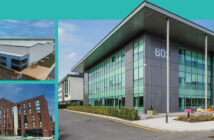Growth is, ironically, a factor that tends to kill unprepared businesses quite often.
In pretty much every market out there, expanding too fast and without proper precautions for the future can quickly lead to disastrous results, and it’s not rare for entrepreneurs to find themselves buried under a mountain of issues that have no viable resolution in sight.
It’s not just about money, either – although most issues obviously boil down to that sooner or later. Lacking to account for factors like the increased property space of your business after a major period of growth or misjudging how much use a certain structure is going to get after investing a lot into it, can lead to serious issues in the long run.
When it comes to dealing with the various physical problems presented by your newfound success, temporary buildings can often prove to be an excellent solution when applied to the correct situations. While they’re not a one-size-fits-all approach in the sense that sometimes investing into permanent structures can be a more viable choice, they’re definitely something to keep on your radar if you frequently find yourself dealing with expansion and relocation problems.
Versatile Business Applications
Most people’s ideas of temporary structures tend to be quite limited, depending on their own experience with them, but the truth is that modern solutions in this field tend to be very versatile and customisable in terms of what one can do with them. From storage space to customer-facing facilities, you can generally go quite far in your integration of temporary structures into your workflow. Some companies may even find it beneficial to maintain a regular contract with a trusted supplier like SmartSpace.co.uk, who’ve been working in the industry for 30 years, in order to ensure that they can always meet their increased demands, regardless of the specific situation.
Another great factor that adds to the versatility of temporary buildings is their easy construction and small set of requirements for the site they’re being deployed on. Most, if not all, surfaces can support a temporary building, including inclined ones, making them great for quick deployment in situations where space is limited.
It should be noted that temporary buildings have some limitations in terms of viable applications due to the nature of their design, but these restrictions are often offset by more relaxed legal regulations surrounding their use. One can typically do much more with temporary buildings without having to apply for regular building permits, although some rules still apply with regards to the use of such facilities.
Another important note is that you may incur some additional costs during your use of temporary buildings, mostly in terms of heating. The buildings themselves tend to be relatively low-maintenance, but their design sometimes makes them difficult to heat properly in colder weather. You should take this into consideration if you’re trying to optimise your budget, especially if you plan on using temporary buildings on a larger scale and are going to invest more significantly in them. You don’t want to find yourself in a situation where you’re at the edge of your budget, but you still need to pay a lot for the support of the buildings over the next few months – that can place a heavy toll on your finances and overall business situation.
Emergency Buffer Space
It’s not rare for companies in retail and manufacturing to run into situations where a sudden surge in orders from a new major client requires them to maintain a significantly larger stock of supplies. When storage space is already tight, to begin with, this can be an obvious issue, especially for budget-strapped businesses.
A common solution to this problem is to use temporary buildings for storing the extra materials until proper storage can be allocated. The few extra months that this can afford should typically be enough to figure out a more permanent solution. In addition, this can allow the company to probe the situation more adequately and figure out if they’re going to need that extra storage in the long run after all – deals can fall through, and when you’ve just invested in a huge storage facility that ate into your budget severely, only to be told that you’re not going to need it at all, it can be devastating. It’s not just about the lost initial cost, but now you’re stuck maintaining a facility that you’re not even using or trying to find a way to sell it.
Another similar type of problem that can be resolved with the use of temporary buildings is training sessions. If your business has to provide training to a number of employees in well-designed facilities, but you don’t see this process repeating in the near future, it’s a good idea to handle it with a temporary structure instead of trying to allocate a permanent facility for the purpose. Sometimes this may not be possible, of course, e.g. when your training relies on highly specialised equipment that’s not suitable for temporary buildings, but in most cases, you should find it to be a pretty much ideal solution. This is especially true when combined with the fact that temporary buildings are highly customisable and can be adapted to different purposes as necessary.
Some training sessions may require you to shift the layout of the space around from time to time, further adding to the viability of temporary buildings as a choice in these cases. Just make sure that you plan ahead in order to avoid running into a situation where you can’t easily make changes to the layout of the facility because even though temporary buildings are quite flexible and adjustable, they still have their limitations depending on what you’re trying to do.
Strong Potential for Manufacturing
A similar situation can arise in manufacturing companies, which may often need to invest in new equipment to meet the demands of a promising new client or market sector. That equipment has to be stored properly, and it can often be hard to gauge the size of the needed facility if you’re purchasing machines one by one. Having an optimised physical layout is critical for achieving top performance, so it’s a bad idea to just build a large facility and start plopping down machines separately over time. This can be a nightmare for reorganisation later, which is the very reason that this reorganisation often never happens at these stages.
Temporary buildings can give you the opportunity to keep your machines safely contained in a workshop that allows you to operate them properly for several months while you determine the requirements of the project properly. That way, you don’t have to waste potential work progress during those months, and you’ll also get a chance to test some configurations in reality before putting them into use on your machines in the final, permanent facility.
When you’re experimenting with different layouts and other factors that can impact the unit’s productivity, having a contract with a good temporary building supplier can be invaluable. It also provides you with the benefit of having someone else to take care of the building construction process, instead of having to oversee that project yourself on top of everything else. Your time is probably already strained as it is, and it’s your most valuable resource in the world of running a company, so it’s important to treat it properly.
Retail Can Benefit Too
Those in the retail business are probably also familiar with issues related to lack of adequate spacing and the logistical problems that can surround these situations, especially when a viable long-term solution is sought. Having to showcase a product at a new location for several months can be problematic if you have no viable options for renting or even purchasing anything in the area. And building permanent housing for something that you’re going to abandon several months down the line is hardly ever a good idea, even if you think you can line up some good deals for selling the place later on.
Temporary buildings can address this problem very elegantly and without costing you too much, allowing you to quickly deploy your presentations at new sites in rapid iterations. Car dealerships are particularly well-known as regular customers of this industry, and for a good reason – they can gain a lot from having extra flexibility in their relocation, given the rapidly moving nature of their market.
It’s not out of the question to even build something like a small temporary store, in case you run into a situation where that would be viable. Large commercial projects that will move away after a few months and need proper support from smaller facilities are a good example of this, and you’d be surprised how flexible you will become in dealing with these issues after integrating temporary buildings into your work. Of course, in some situations, you’ll still want to go with a more permanent solution, especially when you believe the site to have viability in the long run, but for everything else, you should definitely look into what temporary buildings can do for you.




